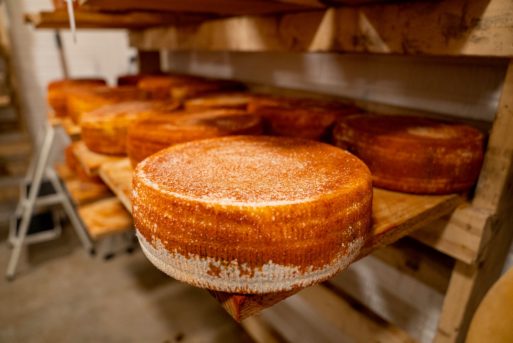
Cheese provides essential nutrients that sustained Swiss villagers through the harsh winter months
It is commonplace to share a meal after the burial of a loved one. Traditional funeral foods span the globe from Irish wake cakes and Mormon potato casserroles to the comforts of southern fried chicken. For generations, the Swiss village of Grimentz served cheese as its main post-burial meal. The aged delicacy may have even been as old as the departed whom the villagers had gathered to mourn.

Villagers breed cows to ensure a milk supply for cheese and other commodities
Winters are long for this little town nestled in the Swiss Alps. For generations, villagers worked hard all summer to preserve nutrient-dense foods to sustain them though the cold months ahead. Cheese made of milk from bovine cows that wandered the steep landscape was a staple commodity in the late 19th and early 20th centuries. Cave-like cellars beneath hillside chalets made for a perfect place to age the winter provision to perfection.
This Alpine community had a tough time honoring their dead with a feast, so villagers would set aside a wheel of cheese dedicated to their own demise. Jean-Jacques Zufferey, a multi-generational inhabitant of Grimentz, recently shared the notion behind this traditional funeral food with “Atlas Obscura,” a comprehensive database of the world’s most wondrous places and foods: “There was the ‘cheese of the dead.’ Everyone had a wheel of cheese so that they had something to serve at their funeral.” Mourners would gather to share wine and savor this notable comestible in honor of their loved one.

Cheese ages and preserves best in cool, dry conditions.
The little Swiss village is now a more prosperous one, so this traditional funeral food is no longer a custom. But Zufferey hopes to find a temperature-controlled museum that could house a few family heirlooms stored in his basement. One wheel of cheese was never devoured by the bereaved when his grandmother died in 1944. The markings suggest it has been preserved since circa 1870. A few wheels from later decades are also in his possession.
However, Zufferey may not hold the title of most mature cheese discovery. A list of oldest cheese in the world includes a large hunk unearthed in an ancient Egyptian tomb circa 13th century BCE, and chunks of cheese tied around the necks of 3600-year-old mummies in China that are thought to be snacks for their afterlife. Perhaps they had planned to share their smatterings on a post-mortem charcuterie board.

 A Traditional Funeral Food as Old as Its History
A Traditional Funeral Food as Old as Its History


 “Songbird” by Fleetwood Mac
“Songbird” by Fleetwood Mac
 First the Wealth Gap, Now the U.S. Has a Growing Health Gap
First the Wealth Gap, Now the U.S. Has a Growing Health Gap
 How to Comfort A Dying Loved One
How to Comfort A Dying Loved One














